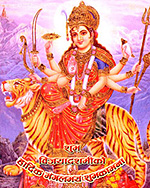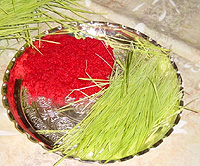|
Dashain
Festivals in Nepal
In preparation for Dashain every home is cleansed and beautifully decorated, painted as an invitation to the mother goddess, so that she may visit and bless the house with good fortune. During this time the reunion of distant and nearby relatives occur in every household. The market is filled with shoppers seeking new clothing, gifts, luxuries and enormous supplies of temple offering for the gods, as well as foodstuffs for the family feasting. Thousands of sheep, goats, ducks, chicken and water buffalo are prepared for the great slaughter. All types of organisations are closed for ten to fifteen days. Labourers are almost impossible to find; from the poor to the rich, all enjoy the festive mood. Anywhere you go the aroma of 'Vijaya Dashami' is found. The first nine days of Dashain are called Nawa Ratri when tantric rites are conducted. In Nepal the life force is embodied in the divine energy and power of the female, depicted as goddess Durga in her many forms. All goddess who emanated from goddess Durga are known as devis, each with different aspects and powers. In most mother goddess temples the deity is represented simply as a sacred Kalash, carved water jug or multiple handed goddess holding murderous weapons. During these nine days people pay their homage to the goddess. If she is properly worshiped and pleased good fortunes are on the way and if angered through neglect then misfortunes are around the corner. Mother goddess is the source of life and everything. The first day of Dashain is called Ghatasthapana, which literally means pot establishing. On this day the kalash, (holy water vessel) symbolising goddess Durga often with her image embossed on the side is placed in the prayer room. The kalash is filled with holy water and covered with cowdung on to which seeds are sown. A small rectangular sand block is made and the kalash is put in the centre. The surrounding bed of sand is also seeded with grains. The ghatasthapana ritual is performed at a certain auspicious moment determined by the astrologers. At that particular moment the priest intones a welcome, requesting goddess Durga to bless the vessel with her presence. The room where the kalash is established is called 'Dashain Ghar'. Generally women are not allowed to enter the room where Dashain puja is being carried out. A priest or a household man worships the kalash everyday once in the morning and then in the evening. The kalash and the sand are sprinkled with holy water everyday and it is shielded from direct sunlight. By the tenth day, the seed will have grown to five or six inches long yellow grass. The sacred yellow grass is called 'Jamara'. It is bestowed by the elders atop the heads of those younger to them during the last five days when tika is put on. The jamara is taken as a token of Goddess Durga as well as the elders blessing. As days passes by regular rituals are observed till the seventh day. The seventh day is called 'Fulpati'. In fulpati, the royal kalash filled with holy water, banana stalks, jamara and sugar cane tied with red cloth is carried by Brahmans on a decorated palanquin under a gold tipped and embroidered umbrella. The government officials also join the fulpati parade. With this the Dashain feasting starts. The eighth day is called the Maha Asthami: The fervour of worship and sacrifice to Durga and Kali increases. On this day many orthodox Hindus will be fasting. Sacrifices are held in almost every house through out the day. The night of the eighth day is called 'Kal Ratri', the dark night. Hundreds of goats, sheep and buffaloes are sacrificed at the mother goddess temples. The sacrifice continues till dawn. While the puja is being carried out great feasts are held in the homes of common people where large amount of meat are consumed. The ninth day is called Nawami: Temples of mother goddess are filled with people from dawn till dusk. Animals mostly black buffaloes are slaughtered to honour Durga the goddess of victory and might and to seek her blessing. Military bands play war tunes, guns boom and officers with beautifully decorated medals in full uniform stand there. When the function ends the courtyard is filled ankle deep with blood. On this very day the god Vishwa Karma, the God of creativity is also worshiped. All factories, vehicles, any machinery instruments and anything from which we make a living are worshiped. We also give sacrifices to all moving machinery like cars, aeroplanes, trucks etc. to get the blessing from goddess Durga for protection for vehicles and their occupants against accidents during the year. The entire day is colourful.
After Dashain everyone settles back
to normal. After receiving the blessing of goddess Durga, people
are ready to work and acquire virtue, power and wealth. Dashain
thus is not only the longest festival but also the most anticipated
one among all the festivals of Nepal.
|
||||||||||||||||||||||||||||||||||||||||||||||||||||||||||||||||||||||||


 The
tenth day is the Dashami: On this day we take tika
and jamara from our elders and receive their blessing. We visit
our elders in their home and get tika from them while our younger
ones come to our home to receive blessing from us. The importance
of Dasain also lies in the fact that on this day family members
from far off and distant relatives come for a visit as well as to
receive tika from the head of the family. This function continues
for four days. After four days of rushing around and meeting your
relatives Dashain ends on the full moon day, the fifteenth day.
In the last day people stay at home and rest. The full moon day
is also called 'Kojagrata' meaning 'who is awake'. The Hindu goddess
of wealth Laxmi is worshipped. On this day the goddess Laxmi is
given an invitation to visit each and everyone.
The
tenth day is the Dashami: On this day we take tika
and jamara from our elders and receive their blessing. We visit
our elders in their home and get tika from them while our younger
ones come to our home to receive blessing from us. The importance
of Dasain also lies in the fact that on this day family members
from far off and distant relatives come for a visit as well as to
receive tika from the head of the family. This function continues
for four days. After four days of rushing around and meeting your
relatives Dashain ends on the full moon day, the fifteenth day.
In the last day people stay at home and rest. The full moon day
is also called 'Kojagrata' meaning 'who is awake'. The Hindu goddess
of wealth Laxmi is worshipped. On this day the goddess Laxmi is
given an invitation to visit each and everyone.